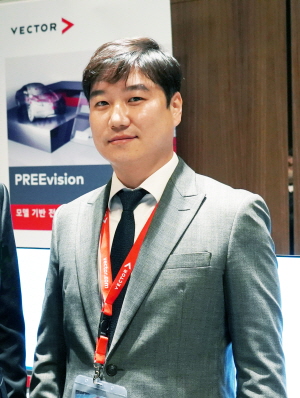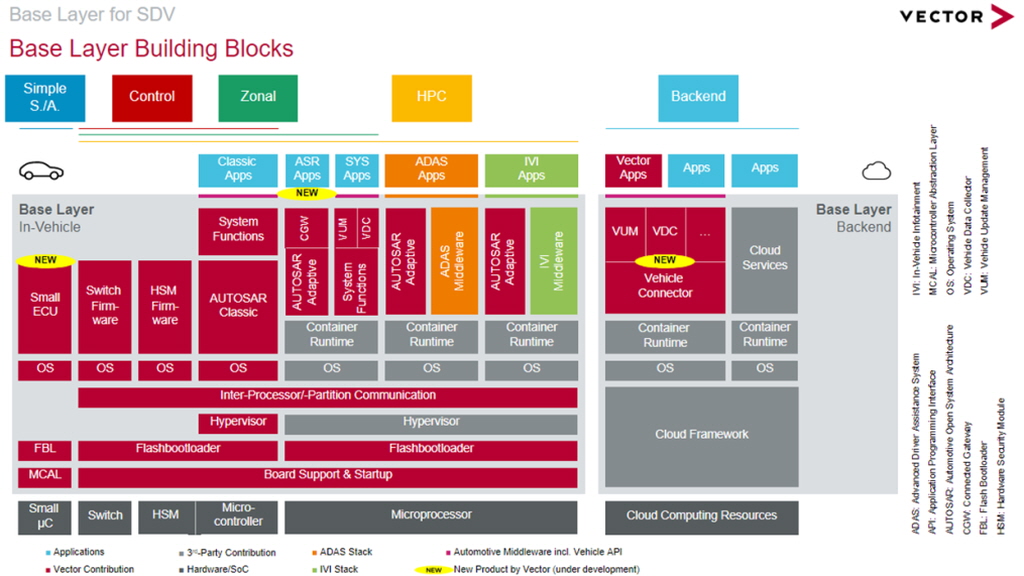
[편집자주] e4ds news와 벡터코리아는 지난 8일 ‘SDV 아키텍처 최신 트렌드’를 주제로 웨비나를 진행했다. 이번 웨비나에서는 제조업에 상당한 영향을 끼치는 자동차 산업이 소프트웨어 중심으로 넘어가는 데에 따른 트렌드의 변화와 함께, SDV의 정의와 특징까지 알아볼 수 있었다. 발표자로 나선 김의열 벡터코리아 사업부장은 Tier사들과 OEM 사이 역할 변화에서 서로가 서로에게 배우고, 새로운 역할을 확립하는 파트너십이 SDV 트렌드의 핵심 성공 요소이며, 글로벌 업체와의 격차를 좁히기 위해서도 국내 업체들의 긴밀한 협업이 필요하다고 다시 한번 강조했다. 김의열 벡터코리아 사업부장은 웨비나 후 시간 관계 상 다 하지 못했던 시청자들의 질문에 대한 답변을 서면으로 전달했다.
■ 현재 적용하고 있는 SDV중 가장 성공적인 사례 및 항후 미래의 SDV는 어떠한 방향으로 발전할지 궁금하다
웨비나에서 설명한 것과 같이 SDV 개발은 현재 진행형이기 때문에 이를 성공적으로 완성한 OEM와 Tier는 아직 없다고 보시는 것이 맞다.
다만 가장 잘 진행하는 OEM은 Mercedes Benz라고 보인다.
그들은 MB.OS 개발 뿐만 아니라 SDV를 통해서 어떤 비즈니스를 만들어야 할지 정확하게 파악하고 있고, 그들의 SW를 만들기 위해 Tier, Tool Vender, Chip Vender, IT Company, Cloud Company 등 다양한 업계와 소통하며 그들의 SW Layer, SW Factory를 구축하고 있다.
지난 2월에 Mercedes에서 발표한 MB.OS에 대한 인사이트는 모든 자동차업계에서 주목을 받을 정도로 동기에서부터 향후 비즈니스 모델에 대한 사항까지 디테일하고 잘 짜여진 계획을 설명했다.
향후 SDV는 다양한 기술적인 한계를 맞이하고 이를 극복하거나 우회하면서 개발이 될 것이다.
한 가지 확실한 것은 차량에서 기존에 없었던 서비스를 경험하게 될 것이라는 것이다.
이러한 경험에서 가장 핵심은 자율주행 기술의 발달이며, 자율주행 기술이 얼마나 성장하느냐에 따라 제공할 수 있는 서비스의 수준이 달라질 것으로 보고 있다.
■ 안전이 핵심인 부분인데 소프트웨어 결함 또는 하드웨어 문제로 안전성 문제가 발생할 경우 품질관리 측면에서 어떤 노력이 필요한지 성과 관련하여 질문 드린다
기존과 동일하게 차량에서 안전은 항상 중요한 사항이고, SDV가 성공적으로 안착되었더라도 안전에 대한 사항은 계속 중요하게 다룰 것이다.
다만 웨비나에서 설명했던 Vehicle EDGE Layer + IT Backend에는 ISO26262의 ASIL 등급 중 최대 ’B’등급 기능들만 존재할 것이며, 기존의 Onboard Layer에는 기존과 동일하게 ASIL ‘D’등급까지 존재하게 될 것이다.
HPC를 설계할 때 많은 기능이 집약된 만큼 Redundancy를 지켜 HW 이중화를 할 가능성이 높으며, HW 문제로 안전성 문제가 발생했을 때 이중화 HW로도 처리하지 못하는 경우 Degrade Function을 사용하여 부분기능처리가 가능하도록 설계하는 것이 중요하다.
품질관리 측면에서는 다중 Command 상황에서 문제가 발생할 수 있는 Test Case를 생성하고 검증하는 것이 필요하다.
이러한 이유 때문에 OEM과 Tier에서는 차량을 가상화하고 검증할 수 있는 환경을 개발하고 있다.
■ 성능과 대역폭 그리고 네트워크 하드웨어 인프라 업그레이드 관련해서 질문 드린다
HPC의 성능은 기존의 수십~수백개의 제어기의 SW를 통합하기 위하여 150~200 KDMIPS 수준의 CPU를 활용할 것으로 보이며, 통신은 1Gbps~10Gbps의 통신속도로 데이터를 주고받을 것으로 예상된다.
마지막 질문이 차량 외측의 네트워크 하드웨어에 대한 질문이라면, V2X에 대한 부분은 스마트시티와 같은 시범용 인프라에 대한 도입은 논의가 되었지만, 실제 인프라 적용에 대한 부분은 진행된 사항이 없어 현 시점에는 답변드리기 어렵다.
■ 법적인 규제 및 규제적 프레임워크 또는 시장 진입 표준에 미치는 어려움은?
현재 유럽에서는 UNECE WP29와 ISO 21434와 같은 법규와 표준이 제정되어 제조사들에게 이를 준수하도록 하고 있다.
이에 국내 OEM에서는 CSMS(Cybersecurity Management System) 그리고 SUMS(Software Update Management System)을 만들어 법규와 표준을 대응하려고 하고 있다.
아직 차량내에 IT 기반 기술이 들어온 지 얼마 지나지 않아 이러한 법규와 표준들은 생소하고 어떤 것들을 해야 하는지 모호한 경우가 많다.
하지만 이 또한 기존의 기능안전이 그러했듯이 시간이 지나면 점차 자연스럽게 받아들여지고, 설계에 반영될 것이라 보고 있다.
■ SDV 개발에 사용이 가능한 유무로 Framework이 있으면 소개 부탁드린다
IT Backend에서 사용가능한 Framework는 Amazon(AWS)와 Microsoft(Azure)등이 있으며, 보안상의 문제로 외부망과 공유하지 못하는 서비스를 위해 OEM들은 자체 Framework도 개발하고 있다.
■ 벡터의 SDV 지원 솔루션과 적용 사례를 알고 싶다
벡터는 차량용 SW에 특화된 회사이므로, 일반적인 차량 개발용 SW들 또한 SDV를 지원한다고 볼 수 있다.
그 중 Service 설계에 특화된 도구를 나열하자면, SDV의 아키텍처와 System을 설계하기 위한 Tool인 PREEvision, Adaptive SW를 설계하고 Code를 Generation할 수 있는 DaVinci, SOA를 검증할 수 있는 CANoe 등을 예시로 들 수 있다.
적용사례는 전세계 과반수 이상의 OEM이 아래 그림에서 붉은색으로 표현되어 있는 Vector Contribution 영역을 공동 개발 중이라고 보면 된다.
 [편집자주] e4ds news와 벡터코리아는 지난 8일 ‘SDV 아키텍처 최신 트렌드’를 주제로 웨비나를 진행했다. 이번 웨비나에서는 제조업에 상당한 영향을 끼치는 자동차 산업이 소프트웨어 중심으로 넘어가는 데에 따른 트렌드의 변화와 함께, SDV의 정의와 특징까지 알아볼 수 있었다. 발표자로 나선 김의열 벡터코리아 사업부장은 Tier사들과 OEM 사이 역할 변화에서 서로가 서로에게 배우고, 새로운 역할을 확립하는 파트너십이 SDV 트렌드의 핵심 성공 요소이며, 글로벌 업체와의 격차를 좁히기 위해서도 국내 업체들의 긴밀한 협업이 필요하다고 다시 한번 강조했다. 김의열 벡터코리아 사업부장은 웨비나 후 시간 관계 상 다 하지 못했던 시청자들의 질문에 대한 답변을 서면으로 전달했다.
[편집자주] e4ds news와 벡터코리아는 지난 8일 ‘SDV 아키텍처 최신 트렌드’를 주제로 웨비나를 진행했다. 이번 웨비나에서는 제조업에 상당한 영향을 끼치는 자동차 산업이 소프트웨어 중심으로 넘어가는 데에 따른 트렌드의 변화와 함께, SDV의 정의와 특징까지 알아볼 수 있었다. 발표자로 나선 김의열 벡터코리아 사업부장은 Tier사들과 OEM 사이 역할 변화에서 서로가 서로에게 배우고, 새로운 역할을 확립하는 파트너십이 SDV 트렌드의 핵심 성공 요소이며, 글로벌 업체와의 격차를 좁히기 위해서도 국내 업체들의 긴밀한 협업이 필요하다고 다시 한번 강조했다. 김의열 벡터코리아 사업부장은 웨비나 후 시간 관계 상 다 하지 못했던 시청자들의 질문에 대한 답변을 서면으로 전달했다.
